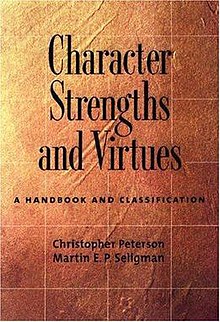Character Strengths And Virtues
The authors of the CSV mention the importance and power of strong, clear principles to any person

Author Christopher Peterson and Martin Seligman
The Character Strengths and Virtues (CSV) handbook of human strengths and virtues, by Christopher Peterson and Martin Seligman, represents the first attempt on the part of the research community to identify and classify the positive psychological traits of human beings.[1] In the same way that the Diagnostic and Statistical Manual of Mental Disorders is used to assess and facilitate research on mental disorders, the CSV is intended to provide a theoretical framework to assist in developing practical applications for positive psychology.[1] The CSV identifies six classes of virtue (i.e. “core virtues”), made up of twenty-four measurable character strengths.
The strengths and virtues
CSV defined character strengths as satisfying most of the ten following criteria. Character strengths are
- fulfilling;
- intrinsically valuable, in an ethical sense (gifts, skills, aptitudes and expertise can be squandered, but character strengths and virtues cannot);
- non-rivalrous;
- not the opposite of a desirable trait (a counterexample is steadfast and flexible, which are opposites but are both commonly seen as desirable);
- trait-like (habitual patterns that are relatively stable over time);
- not a combination of the other character strengths in the CSV;
- personified (at least in the popular imagination) by people made famous through story, song, etc.;
- observable in child prodigies (though this criterion is not applicable to all character strengths);
- absent in some individuals;
- and nurtured by societal norms and institutions.
The introduction of CSV suggests that these six virtues are considered good by the vast majority of cultures and throughout history and that these traits lead to increased happiness when practiced. Notwithstanding numerous cautions and caveats, this suggestion of universality hints that in addition to trying to broaden the scope of psychological research to include mental wellness, the leaders of the positive psychology movement are challenging moral relativism and suggesting that virtue has a biological basis.[1] These arguments are in line with the Science of morality.
Each of the twenty-four character traits is defined behaviorally, with psychometric evidence demonstrating that it can be reliably measured.[2] The book shows that “empirically minded humanists can measure character strengths and virtues in a rigorous scientific manner.”[2]
Socrates is widely believed to have possessed all of the CSV’s virtues (whether one groups them into six or even just three)
Practical applications of positive psychology include helping individuals and organizations correctly identify their strengths and use them to increase and sustain their respective levels of well-being. Each trait “provides one of many alternative paths to virtue and well-being.”[2]Therapists, counselors, coaches, and various other psychological professionals can use the new methods and techniques to build and broaden the lives of individuals who are not necessarily suffering from mental illness or disorder.
Finally, other researchers have advocated grouping the 24 identified character traits into just four classes of strength (Intellectual, Social, Temperance, Transcendent) or even just three classes (without Transcendence). This, not just because it is easier to remember, but rather because there is evidence that these do an adequate job of capturing the components of the 24 original traits[3].
List from the book
The organization of these virtues and strengths in the book is as follows.[1]
- Wisdom and Knowledge (strengths that involve the acquisition and use of knowledge)
- creativity (personified for example by Albert Einstein)
- curiosity (personified for example by John C. Lilly)
- open-mindedness (personified for example by William James)
- love of learning (personified for example by Benjamin Franklin)
- perspective and wisdom (personified for example by Ann Landers): the coordination of “knowledge and experience” and “its deliberate use to improve wellbeing.”[4] Many, but not all, studies find that adults’ self-ratings of perspective/wisdom do not depend on age.[5] This stands in contrast to the popular notion that wisdom increases with age.[5]
- Courage (strengths that allow one to accomplish goals in the face of opposition)
- bravery (personified for example by Ernest Shackleton)
- persistence (personified for example by John D. Rockefeller)
- integrity (personified for example by Sojourner Truth)
- vitality (personified for example by the Dalai Lama)
- Humanity (strengths of tending and befriending others)
- love (personified for example by Romeo and Juliet)
- kindness (personified for example by Cicely Saunders)
- social intelligence (personified for example by Robert Kennedy)
- Justice (strengths that build healthy community)
- active citizenship / social responsibility / loyalty / teamwork (personified for example by Sam Nzima)
- fairness (personified for example by Mohandas Gandhi)
- leadership
- Temperance (strengths that protect against excess)
- forgiveness and mercy (personified for example by Pope John Paul II)
- humility and modesty (personified for example by Bill W., co-founder of Alcoholics Anonymous)
- prudence (personified for example by Fred Soper)
- self-regulation and self control (personified for example by Jerry Rice)
- Transcendence (strengths that forge connections to the larger universe and provide meaning)
- appreciation of beauty and appreciation of excellence (personified for example by Walt Whitman)
- gratitude (personified for example by G. K. Chesterton)
- hope (personified for example by Martin Luther King, Jr.)
- humor and playfulness (personified for example by Mark Twain)
- spirituality (personified for example by Albert Schweitzer)
References
- Peterson, Christopher; Seligman, Martin E. P. (2004). Character strengths and virtues: A handbook and classification.. Oxford: Oxford University Press. ISBN 0-19-516701-5.
- Cloninger, C. Robert (2005). “Character Strengths and Virtues: A Handbook and Classification”. American Journal of Psychiatry (American Psychiatric Association) 162 (162): 820–821. doi:10.1176/appi.ajp.162.4.820-a. http://ajp.psychiatryonline.org/cgi/content/full/162/4/820-a. Retrieved 2007-04-05.
- Jessica Shryack, Michael F. Steger, Robert F. Krueger, Christopher S. Kallie. 2010. The structure of virtue: An empirical investigation of the dimensionality of the virtues in action inventory of strengths. Elsevier.
- Peterson, Christopher; Seligman, Martin E. P. (2004). Character strengths and virtues: A handbook and classification.. Oxford: Oxford University Press. p. 106. ISBN 0-19-516701-5.
Adapted from Wikipedia, the free encyclopedia
